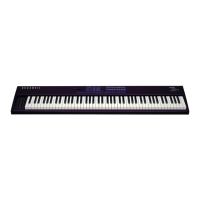4-6
MIDI Setups Mode
Parameter Summary
Velocity Curve
1-8
Allows you to alter the relationship between keyboard playing effort (keystroke
velocity) and the resulting sound volume in this zone. Below are sketches of these
curves.
Figure 4-2 Velocity Curves
You can use Velocity Curves is several ways. Number 1 is normal but you can use 2
and 3 to alter the keyboard response to favor softer playing (2) or louder playing (3)
without a loss of dynamic range. The others are typically used with overlapping zones
(see Low Key, High Key, and Transpose) to create ÒcrossfadesÓ (see More on Keyboard
Splits on page 4-11).
Reverb Wet/Dry, Chorus Wet/Dry
0-100, Noc
This is the effect intensity for the internal effect selected for this setup. ItÕs the same for
both zones.
A Ribbon
0-129 and Off
SpeciÞes where signals from the left ribbon are sent for this zone. Default is Pitch Bend
(128). See MIDI Controller Destinations on page 4-7 for a description of MIDI
destination numbers. Note that the Stage PianoÕs sounds do not respond to Pitch
Bend.
Hold or Center
Hld, Ctr
SpeciÞes whether the A ribbon signal remains at its last value or returns to center
when your Þnger is lifted. Default is Center (Ctr).
Key
0
1 Linear
Velocity
2 Expand 3 Compress 4 Bump
5 Reverse 6 Reverse Expand 7 Reverse Compress 8 Dip
0
Max
Volume
127

